Gold Prospects in the Western Segment of the Russian Arctic: Regional Metallogeny and Distribution of Mineralization
Abstract
:1. Introduction
- A deposit—a concentration of minerals on the surface or underground with delineated mineralized bodies and indicated or inferred resources; quantity, quality, and bedding of the ore meet the exploitation requirements;
- An occurrence—mineralized rocks with gold content over 1 ppm for more than 1-m thickness according to core or trench sampling, with an undefined scale of mineralization and no contoured mineralized bodies;
- Points of gold mineralization—small occurrences with gold content more than 0.1 ppm for thickness over 1 m in core or trench samples, or more than 1 ppm in hand samples.
- Asp—arsenopyrite, Cc—calcite, Cp—chalcopyrite, Di—diopside, Gr—garnet, Grs—gersdorfite, Hb—hornblende, Lo—löllingite, Mr—marcasite, Pl—plagioclase, Po—pyrrhotite, Py—pyrite, Qu—quartz, Tit—titanite, Uy—Uytenbogaardtite, and Zo—zoisite.
2. Materials and Methods
3. Geological Setting
4. Brief Information on Gold Deposits in the Western Segment of the Russian Arctic
4.1. Gold Deposits in the Kolmozero–Voron’ya Greenstone Belt
4.2. Gold Deposits and Occurrences in the Strel’na Greenstone Belt
4.3. Gold Occurrences in the Tiksheozero Greenstone Belt
4.4. Gold in BIF Deposits in the Olenegorsk Greenstone Belt
4.5. South Pechenga Zone of the Pechenga Greenschist Belt
4.6. The Salla–Kuolajarvi Belt
- The temperature of homogenization of fluid inclusions in quartz from propylite is 350–430 °C. The fluids have very high salinity (up to 25–35 wt.% NaCl-equivalent), and its composition changed in time from NaCl to MgCl.
- The temperature of homogenization of fluid inclusions in non-mineralized quartz is 300–350 °C, the composition of the fluid is H2O–NaCl, the salinity is moderate, 3–7 wt.% NaCl-equivalent
- In granular quartz with gold mineralization the temperature of homogenization of fluid inclusions is 190–270 °С, the fluid composition is CO2–CH4 with very high methane content from 16–25 to 62–70 mas.%, increasing with the approach to the chalcopyrite grain; the salinity of the fluid is high with 22–28 wt.% CaCl2-equivalent, CaCl2 dominates. The pressure is estimated at 0.5–0.94 kbar.
5. Distribution and Timing of Formation of Gold Deposits in the Northeastern Part of the FenNoscandian Shield
- Mafic-ultramafic metavolcanics play a principal role in the Oleninskoe, Sergozerskoe, Mayskoe deposits, and in the Kichany gold occurrence (Tiksheozero belt).
- Metasedimentary terrigenous rocks host gold mineralization in BIF deposits of the Olenegorsk group, in the Porojarvi occurrence (South Pechenga), and in the Vorgovy occurrence (the Strel’na belt).
- Diorite porphyry intrusion hosts mineralization in the Nyal’m deposit. Except the Nyal’m, diorite porphyry dykes in mafic volcanics contain gold mineralization in the Oleninskoe and Sergozerskoe deposits, but it is unclear if these dykes play any role in mobilization and/or deposition of gold.
- Fluids of H2O–CO2 composition with low (0.4–7.7 wt.% NaCl-equivalent) salinity (Nyal’m, Porojarvi, vein quartz in Mayskoe deposit).
- Fluids of H2O–CO2 composition with high (13–35 wt.% NaCl-equivalent) salinity (Oleninskoe, quartz from propylite in Mayskoe deposit).
- Fluids of CH4–CO2 composition with high salinity 22–28 wt.% NaCl-equivalent (quartz with gold in Mayskoe deposit).
6. Conclusions and Implications
Author Contributions
Funding
Acknowledgments
Conflicts of Interest
References
- State Report ‘On Statute and Exploitation of Mineral Resources of Russian Federation in 2015’. Available online: http://www.mnr.gov.ru/docs/gosudarstvennye_doklady/o_sostoyanii_i_ispolzovanii_mineralno_syrevykh_resursov_rossiyskoy_federatsii/ (accessed on 16 September 2018). (In Russian)
- Subbotin, V.V.; Gabov, D.A.; Korchagin, A.U.; Savchenko, Y.E. Gold and Silver in the Composition of PGE Ores of the Fedorov-Pana Layered Intrusive Complex. Herald Kola Sci. Centre RAS 2017, 1, 53–65. (In Russian) [Google Scholar]
- Ward, M.; Kalinin, A.; McLaughlin, D.; Voytekhovich, V. Kola Mining Geological Company Ltd (KMGC)—Prospecting for PGE in the East Pansky layered massif. In The Neighborhood Cooperation and Eperience Exchange of Geological Prospecting and Survey of PGE Deposits in the Northern Fennoscandia; KNTs RAN: Apatity, Russia, 2008; pp. 52–55. [Google Scholar]
- Eilu, P.; Rasilainen, K.; Halkoaho, T.; Huovinen, I.; Karkkainen, N.; Kontoniemi, O.; Lepisto, K.; Niiranen, T.; Sorjonen-Ward, P. Quantitative Assessment of Undiscovered Resources in Orogenic Gold Deposits in Finland; Report of Investigation 216; Geological Survey of Finland: Espoo, Finland, 2015; 318p, ISBN 978-952-217-331-7. [Google Scholar]
- Rasilainen, K.; Eilu, P.; Halkoaho, T. Assessment of undiscovered metal resources in Finland. Ore Geol. Rev. 2017, 86, 896–923. [Google Scholar] [CrossRef]
- Suurikuusikko Mineral Deposit Report. Geological Survey of Finland. Available online: http://tupa.gtk.fi/karttasovellus/mdae/raportti/386_Suurikuusikko.pdf (accessed on 22 June 2018).
- Eilu, P.; Pankka, H. Fingold—A Public Database on Gold Deposits in Finland; Geological Survey of Finland: Espoo, Finland, 2013; Available online: http://en.gtk.fi/informationservices/palvelukuvaukset/fingold.html (accessed on 21 March 2016).
- Mints, M.V.; Suleimanov, A.K.; Babayants, P.S. Deep Structure, Evolution, and Minerals in the Early Precabrian Basement of the East European Platform: Interpretation of Materials on Referent Profile 1-EV, Profiles 4V and TATSEIS; GEOKART GEOS: Moscow, Russia, 2010; ISBN 978-5-89118-531-9. (In Russian) [Google Scholar]
- Sundblad, K. Metallogeny of Gold in the Precambrian of Northern Europe. Econ. Geol. 2003, 98, 1271–1290. [Google Scholar] [CrossRef]
- Eilu, P. (Ed.) Mineral Deposits and Metallogeny of Fennoscandia; Special Paper; Geological Survey of Finland: Espoo, Finland, 2012; Volume 53, 401p, ISBN 978-952-217-175-7. [Google Scholar]
- Borisenko, A.S. Cryometric study of salt composition of the gas–liquid inclusions in minerals. Geol. Geofiz. 1977, 8, 16–27. [Google Scholar]
- Bodnar, R.J.; Vityk, M.O. Interpretation of microterhmometric data for H2O-NaCl fluid inclusions. In Fluid Inclusionsin Minerals: Methods and Applications; Benedetto DeVivo & Maria Luce Frezzotti, Pontignano: Siena, Italy, 1994; pp. 117–130. [Google Scholar]
- Collins, P.L.P. Gas hydrates in CO2-bearing fluid inclusions and the use of freezing data for estimation of salinity. Econ. Geol. 1979, 74, 1435–1444. [Google Scholar] [CrossRef]
- Brown, P. FLINCOR: A computer program for the reduction and investigation of fluid inclusion data. Am. Mineral. 1989, 74, 1390–1393. [Google Scholar]
- Daly, J.S.; Balagansky, V.V.; Timmerman, M.J.; Whitehouse, M.J. The Lapland-Kola orogen: Palaeoproterozoic collision and accretion of the northern Fennoscandian lithosphere. Geol. Soc. Lond. Mem. 2006, 32, 579–598. [Google Scholar] [CrossRef]
- Korovkin, V.A.; Turyleva, L.V.; Rudenko, D.G.; Zhuravlev, V.A.; Klyuchnikova, G.N. Underground of the North-West of Russian Federation; VSEGEI: Sankt-Peterburg, Russia, 2003; 754p. (In Russian) [Google Scholar]
- Kalinin, A.A.; Savchenko, Y.E.; Selivanova, Y.A. Minerals of precious metals in the Oleninskoe gold deposit (Kola peninsula). Zapiski RMO 2017, 146, 43–58. (In Russian) [Google Scholar]
- Ovoca Gold plc Operational Update 13/09/2007. Available online: http://www.ovocagold.com/upload/20070913_ayax__kola_&_goltsovoye_update.pdf (accessed on 2 April 2017).
- Volkov, A.V.; Novikov, I.A. The Oleninskoe gold sulfide deposit (Kola peninsula, Russia). Geol. Ore Deposits 2002, 44, 361–372. [Google Scholar]
- Kudryashov, N.M.; Kalinin, A.A.; Lyalina, L.M.; Serov, P.A.; Elizarov, D.V. Geochronological and isotope geochemical characteristics of rocks, hosting gold occurrences in the Archean greenstone belt Kolmozero-Voron’ya (Kola region). Lithosphere 2015, 6, 83–100. (In Russian) [Google Scholar]
- Kudryashov, N.M.; Lyalina, L.M.; Apanasevich, E.A. Age of rare metal pegmatites from the Vasin Myl’k deposit (Kola region): Evidence from of U-Pb geochronology of microlite. Dokl. AN 2015, 461, 321–325. [Google Scholar] [CrossRef]
- Prokofiev, V.Y.; Kalinin, A.A.; Lobanov, K.V.; Banks, A.A.; Borovikov, D.A.; Chicherov, M.V. Composition of Fluids Responsible for Gold Mineralization in the Pechenga Structure of the Pechenga–Imandra–Varzuga Greenstone Belt, Kola Peninsula, Russia. Geol. Ore Depos. 2018, 60, 277–299. [Google Scholar] [CrossRef]
- Safonov, Yu.G.; Volkov, A.V.; Vol’fson, A.A.; Genkin, A.D.; Krylova, T.L.; Chugaev, A.V. The Maysk quartz gold deposit (Northern Karelia): Geological, mineralogical, and geochemical studies and some genetic problems. Geol. Ore Depos. 2003, 45, 375–394. [Google Scholar]
- Gavrilenko, B.V. Minerageny of Precious Metals and Diamonds in the North-Eastern Part of the Baltic Shield. Ph.D. Thesis, Moscow University, Moscow, Russia, 2003; 60p. (In Russian). [Google Scholar]
- Kalinin, A.A.; Galkin, N.N. The Precambrian Copper-Molybdenum porphyry deposit Pellapahk (Kolmozero-Voron’ya greenstone belt). Vestnik KNTs RAN 2012, 44, 80–92. (In Russian) [Google Scholar]
- Kalinin, A.A.; Kazanov, O.V.; Kudryashov, N.M.; Bakaev, G.F.; Petrov, S.V.; Elizarov, D.V.; Lyalina, L.M. New promising gold objects in the Strelna greenstone belt, Kola Peninsula. Geol. Ore Depos. 2017, 59, 453–481. [Google Scholar] [CrossRef]
- Bibikova, E.V.; Bogdanova, S.V.; Glebovitsky, V.A.; Claesson, S.; Skiöld, T. Evolution of the Belomorian belt: NORDSIM U-Pb zircon dating of the Chupa paragneisses, magmatism, and metamorphic stages. Petrology 2004, 12, 195–210. [Google Scholar]
- Kalinin, A.A.; Astaf’ev, B.Y.; Voinova, O.A.; Bayanova, T.B.; Khiller, V.V. Geological structure and prospects for minerals of the Tiksheozero greenstone belt. Lithosphere 2017, 17, 102–126. (In Russian) [Google Scholar] [CrossRef]
- Starostin, V.I.; Pelymskiy, G.A.; Leonenko, E.I.; Sakiya, D.R. Gold in BIF deposits of the East European platform. Izvestiya RAEN 2005, 14, 27–42. (In Russian) [Google Scholar]
- Golikov, N.N.; Goryainov, P.M.; Ivanyuk, G.Y.; Pahomovskiy, Ya.A.; Yakovenchuk, V.N. Auriferous iron formations of the Olenegorsk deposit (Kola Peninsula, Russia). Geol. Ore Depos. 1999, 41, 144–151. [Google Scholar]
- Bazay, A.V.; Ivanyuk, G.Y. Native metals in the rocks of BIF in the Kola Peninsula. Zapiski RMO 2008, 5, 34–47. (In Russian) [Google Scholar]
- Ivanyuk, G.Y.; Bazay, A.V.; Pakhomovskiy, Y.A.; Yakovenchuk, V.N.; Goryainov, P.M. Low temperature hydrothermal veins in the rocks of the Archean ferriferrous formation. Zapiski VMO 2001, 3, 16–28. (In Russian) [Google Scholar]
- Goryainov, P.M.; Ivanyuk, G.Y.; Bayanova, T.B.; Bazay, A.V.; Astaf’ev, B.Y.; Voinova, O.A. Composition, genesis, and age of rare-earth and precious metal mineralization in the rocks of banded iron formation in the Kola Peninsula. Proc. Fersman Sci. Sess. 2012, 9, 235–238. (In Russian) [Google Scholar]
- Melezhik, V.A.; Sturt, B.A. General geology and evolutionary of the early Proterozoic Polmak-Pasvik-Pechenga-Imandra/Varzuga-Ust’Ponoy Greenstone Belt in the northeastern Baltic Shield. Earth Sci. Rev. 1994, 36, 205–241. [Google Scholar] [CrossRef]
- Duk, G.G. Structural Metamorphic Evolution of the Rocks in the Pechenga Complex; Nauka: Moscow-Leningrad, Russia, 1977; 104p. (In Russian) [Google Scholar]
- Ahmedov, A.M.; Voron’yaeva, L.V.; Pavlov, V.A.; Krupenik, V.A.; Kuznetsov, V.A.; Sveshnikova, K.Yu. Gold mineralization in the Southern-Pechenga structural zone (Kola Peninsula): Types of occurrences and prospects for finding economic gold grades. Region. Geol. Metall. 2004, 20, 139–151. (In Russian) [Google Scholar]
- Voron’yaeva, L.V. Geology and Gold Mineralization in the Southern Pechenga Structural Zone. Ph.D. Thesis, VSEGEI, Sankt-Peterburg, Russia, 2008. (In Russian). [Google Scholar]
- Kalinin, A.A.; Bayanova, T.B.; Lyalina, L.M.; Serov, P.A.; Elizarov, D.V. Occurrences of gold mineralization in the Southern Pechenga structural zone: New isotope geochronological data. In Geology and Geochronology of the Rock-Forming and Ore Processes in Crystalline Shields, Proceedings of All-Russian (with International Participation) Conference, Apatity, Russia, 8–12 July 2013; K & M: Apatity, Russia, 2013; pp. 69–71. (In Russian) [Google Scholar]
- Bushmin, S.A.; Belyatskiy, B.V.; Krymskiy, R.Sh.; Glebovitskiy, V.A.; Buyko, A.K.; Savva, E.V.; Sergeev, S.A. Isochron Re-Os age of gold from Mayskoe gold-quartz vein deposit (Northern Karelia, Baltic Shield). Dokl. AN 2013, 448, 54–57. [Google Scholar] [CrossRef]
- Balashov, Y.A. Geochronology of the Early Proterozoic rocks of the Pechenga-Varzuga structure in the Kola Peninsula. Petrology 1995, 4, 3–25. (In Russian) [Google Scholar]
- Kulikov, V.S.; Kulikova, V.V. The Kuolajarvi synclinorium: A new view on the geological structure and combined cross section. In Trudy Karel’skogo Nauchnogo Tsentra RAN; Russian Academy of Sciences: Petrozavodsk, Russia, 2014; pp. 28–38. (In Russian) [Google Scholar]
- Vol’fson, A.A.; Rusinov, V.L.; Krylova, T.L.; Chugaev, A.V. Metasomatic alterations in Precambrian metabasites of the Salla-Kuolajarvi graben near the Mayskoe gold field, Northern Karelia. Petrology 2005, 13, 161–186. [Google Scholar]
- Gavrilenko, B.V.; Rezhenova, S.A. Ore minerals in gold-bearing quartz vein zones. In Mineral’nye ParageNezisy Metamorficheskih i Metasomaticheskih Porod (Mineral Paragenesis in Metamorphic and Metasomatic rocks); Kola Filial AN SSSR: Apatity, Russia, 1987; pp. 58–67. (In Russian) [Google Scholar]
- Kalinin, A.A.; Karpov, S.M.; Kalachyova, A.B.; Savchenko, Y.E. New data on mineralogy of the Mayskoe gold-quartz deposit (Northern Karelia). In Trudy Fersmanovskoy Nauchnoy Sessii GI KNTs RAN (Proceedings of the Fersman Scientific Session); Kola Scientific Center of RAS: Apatity, Russia, 2018; pp. 172–175. (In Russian) [Google Scholar]
- Vol’fson, A.A.; Chugaev, A.V.; Safonov, Y.G.; Rusinov, V.L.; Krylova, T.L. Results of Rb-Sr, Rb-Rb study of gold field Mayskoe, Northern Karelia. In Isotope Dating of Geological Processes: New Methods and Results: Abstracts of Russian Conference, Moscow, Russia, 15–17 November 2000; GEOS: Moscow, Russia, 2000; pp. 93–96. (In Russian) [Google Scholar]
- Phillips, G.N.; Powell, R. Formation of gold deposits: A metamorphic devolatilization model. J. Metamorph. Geol. 2010, 28, 689–718. [Google Scholar] [CrossRef]
- Belyaev, O.A.; Bushmin, S.A.; Voinov, A.S.; Volodichev, O.I.; Glebovitsky, V.A. Map of Mineral Facies of Metamorphic Rocks in the Eastern Baltic Shield in the Scale 1:1 500 000; Glebovitskiy, V.A., Ed.; VSEGEI, IPGGRAS: Sankt-Peterburg, Russia, 1991. [Google Scholar]
- Zhu, Y.; An, F.; Tan, J. Geochemistry of hydrothermal gold deposits: A review. Geosci. Front. 2011, 2, 367–374. [Google Scholar] [CrossRef]
- Pokrovski, G.S.; Akinfiev, N.N.; Borisova, A.Y.; Zotov, A.V.; Kouzmanov, K. Gold speciation and transport in geological fluids: Insights from experiments and physical-chemical modeling. Geol. Soc. Lond. Spec. Publ. 2014, 402, 9–70. [Google Scholar] [CrossRef]
- Toulmin, P.; Barton, P.B. A thermodynamic study of pyrite and pyrrhotite. Geochim. Cosmochim. Acta 1964, 28, 641–671. [Google Scholar] [CrossRef]
- Goldfarb, R.J.; Groves, D.I.; Gardoll, S. Orogenic Gold and geologic time: A global synthesis. Ore Geol. Rev. 2001, 18, 1–75. [Google Scholar] [CrossRef]
- Rasilainen, K.; Eilu, P.; Halkoaho, T.; Iljina, M.; Karinen, T. Quantitative mineral resource assessment of undiscovered PGE resources in Finland. Ore Geol. Rev. 2010, 38, 270–287. [Google Scholar] [CrossRef]
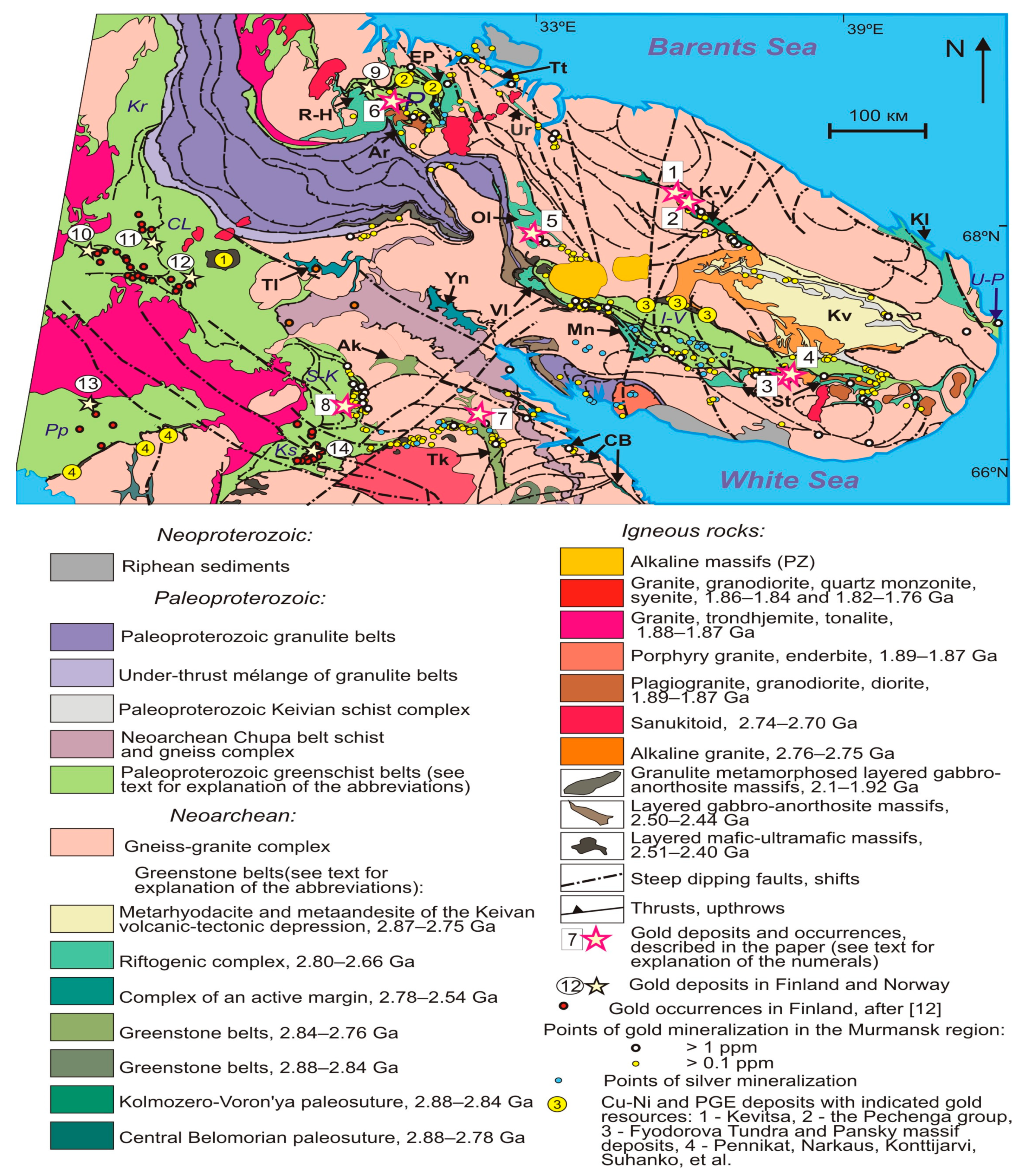
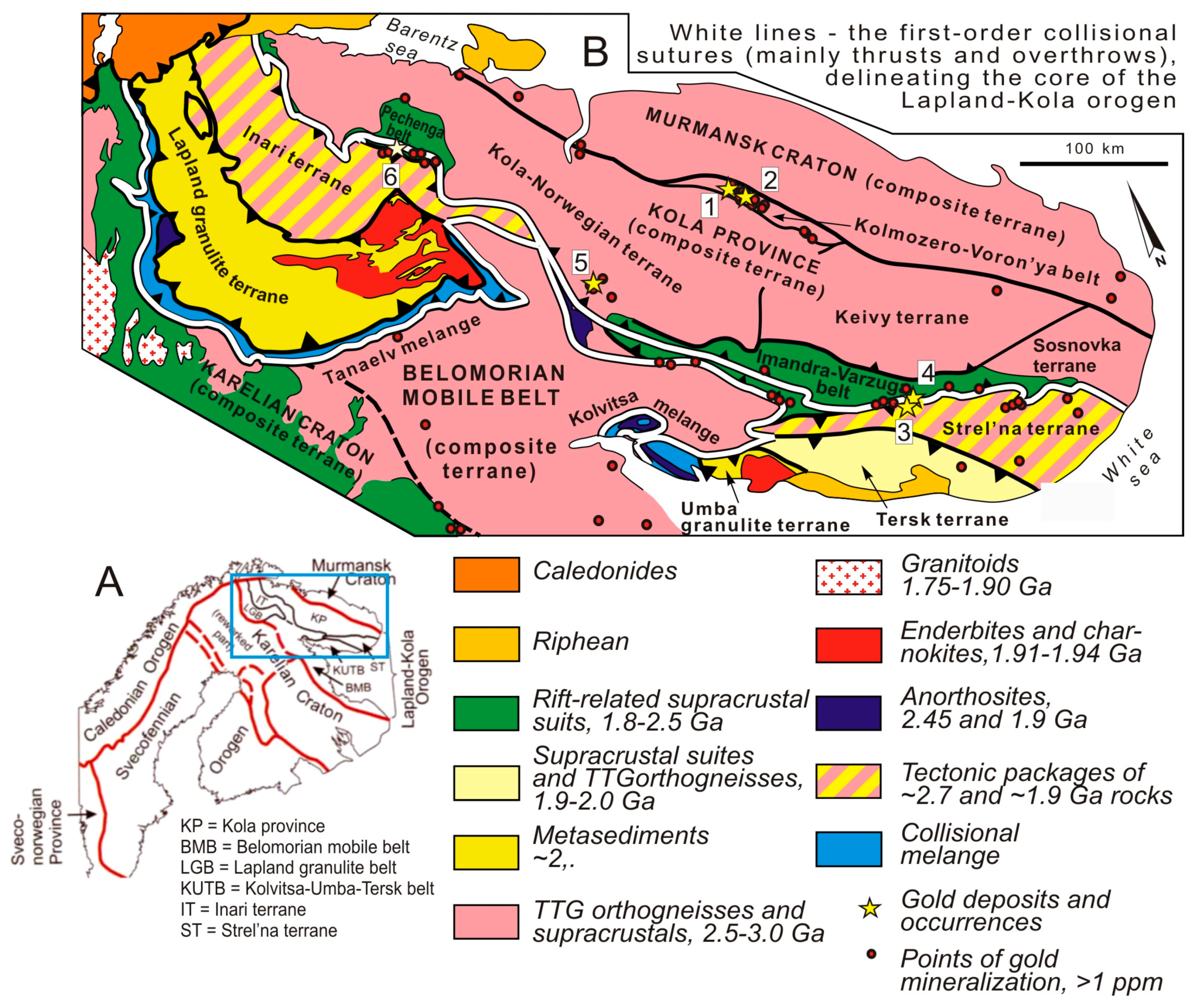
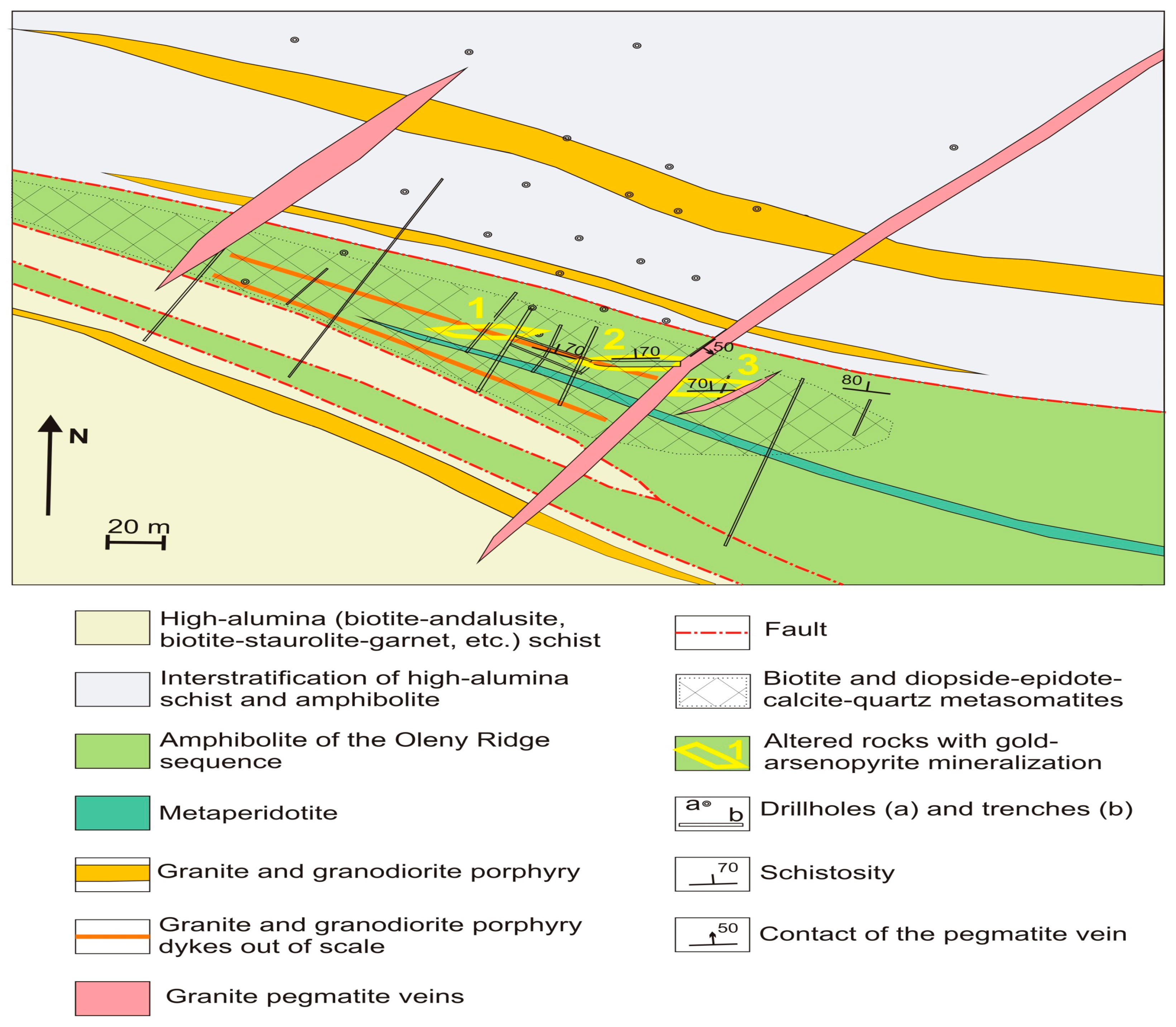
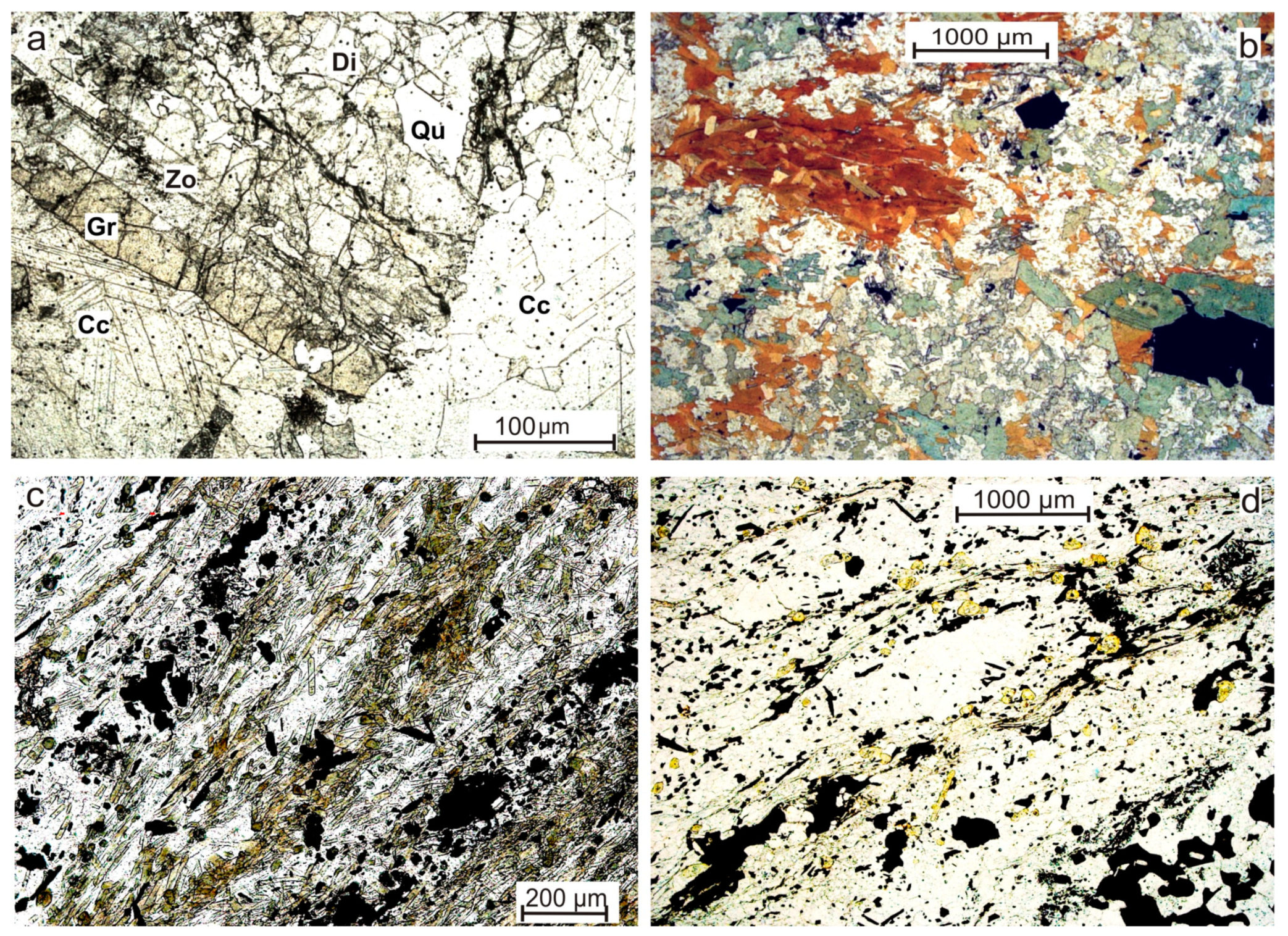
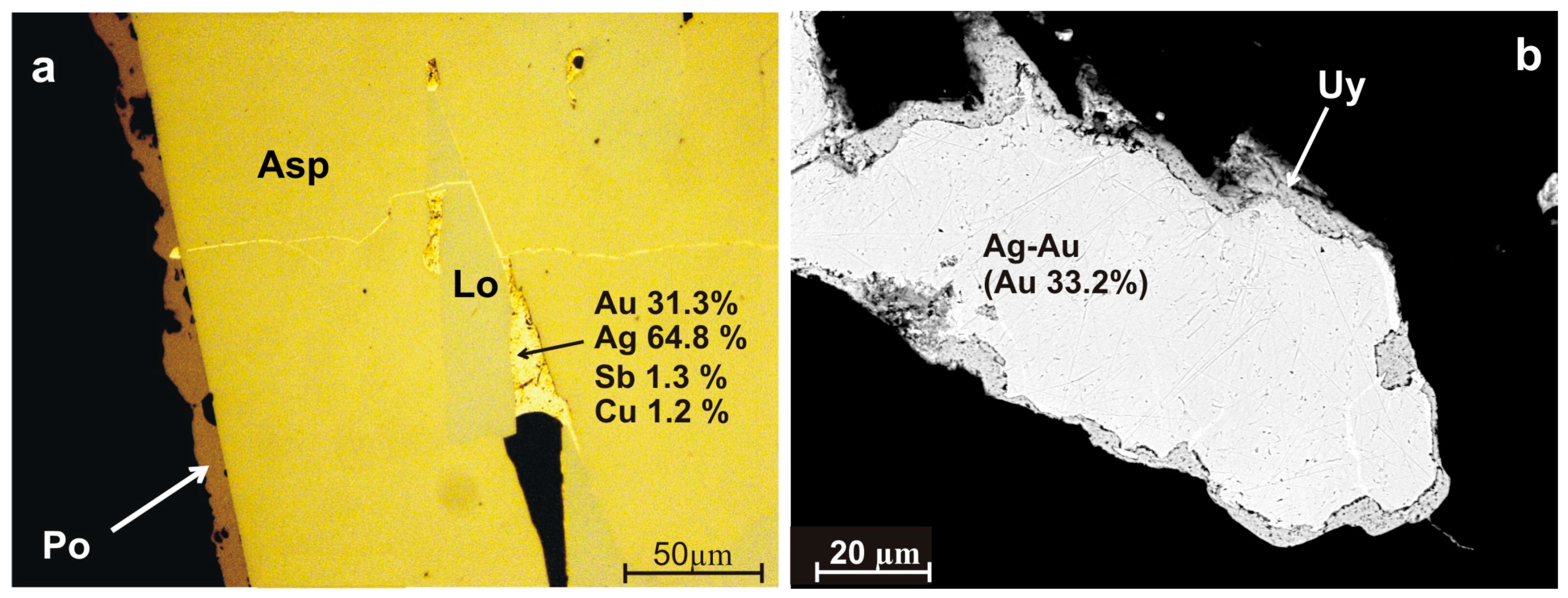
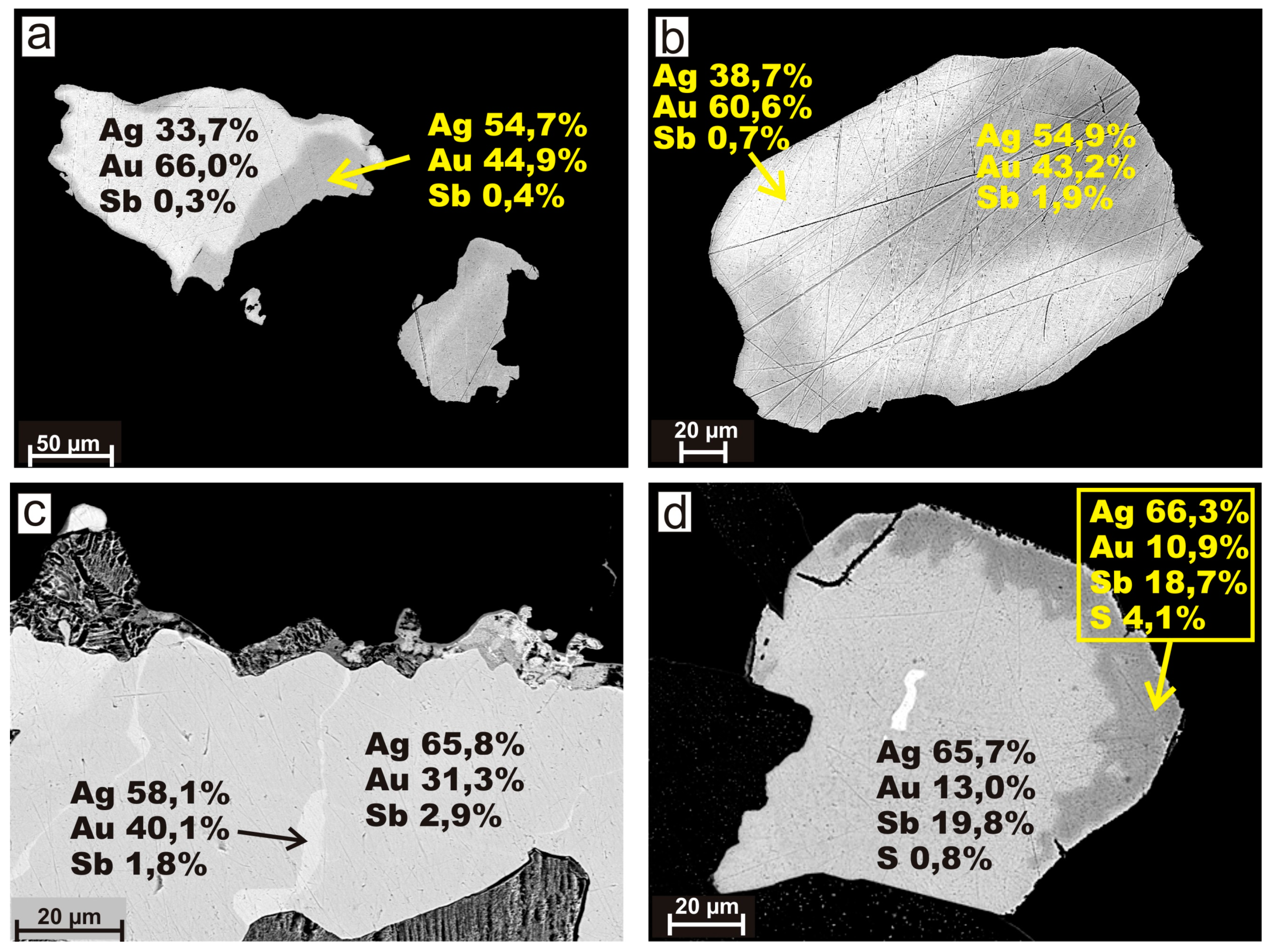
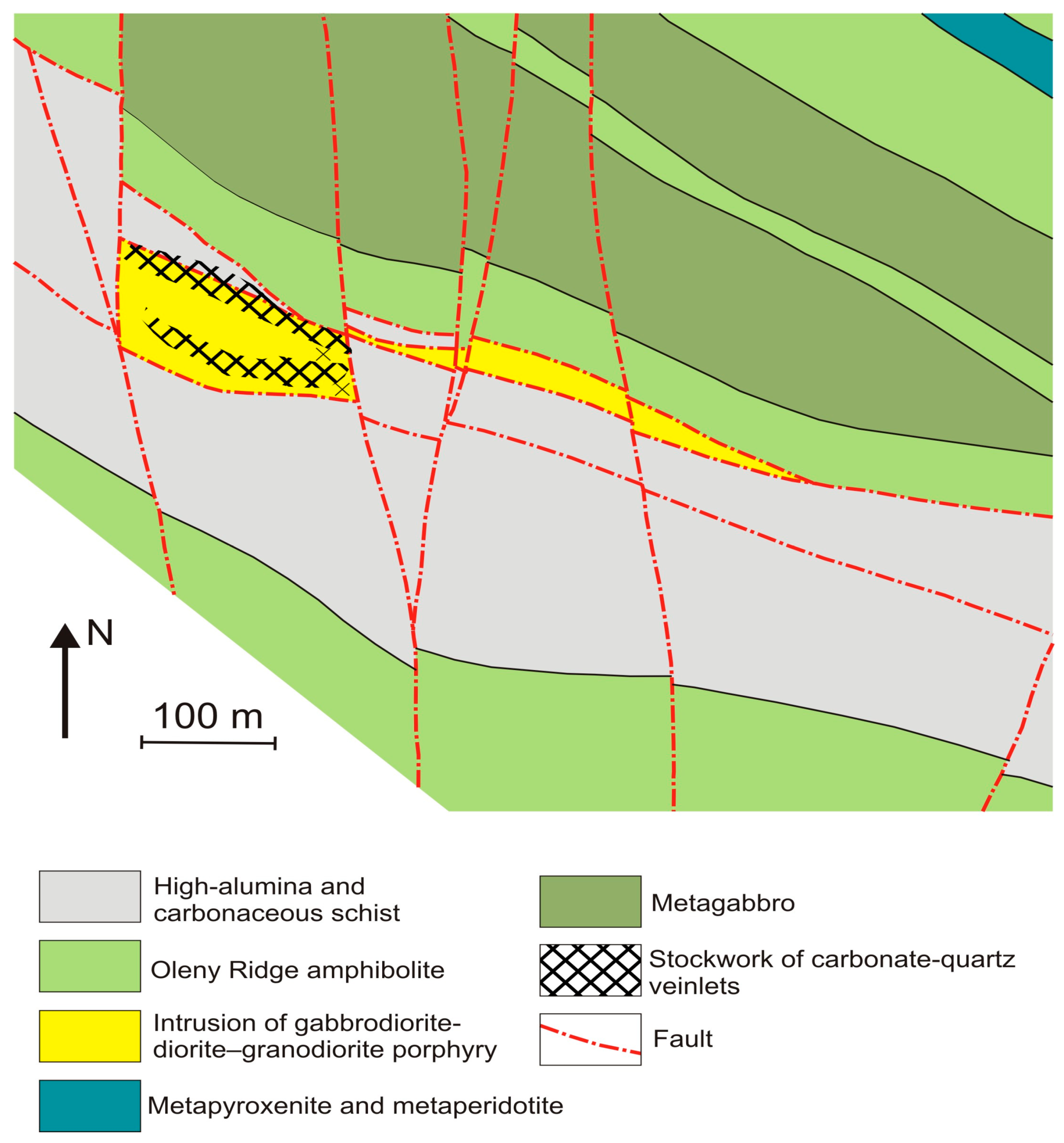
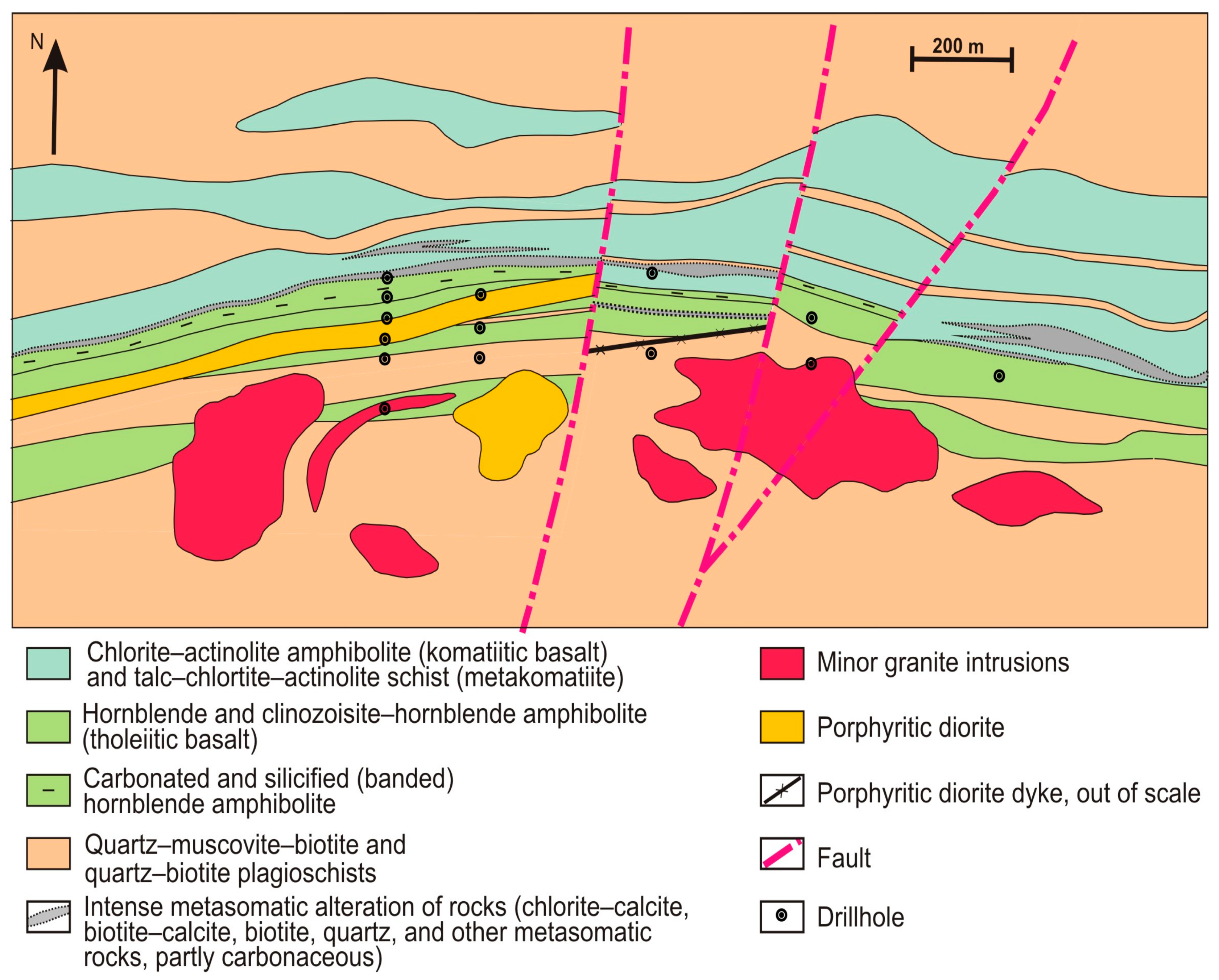
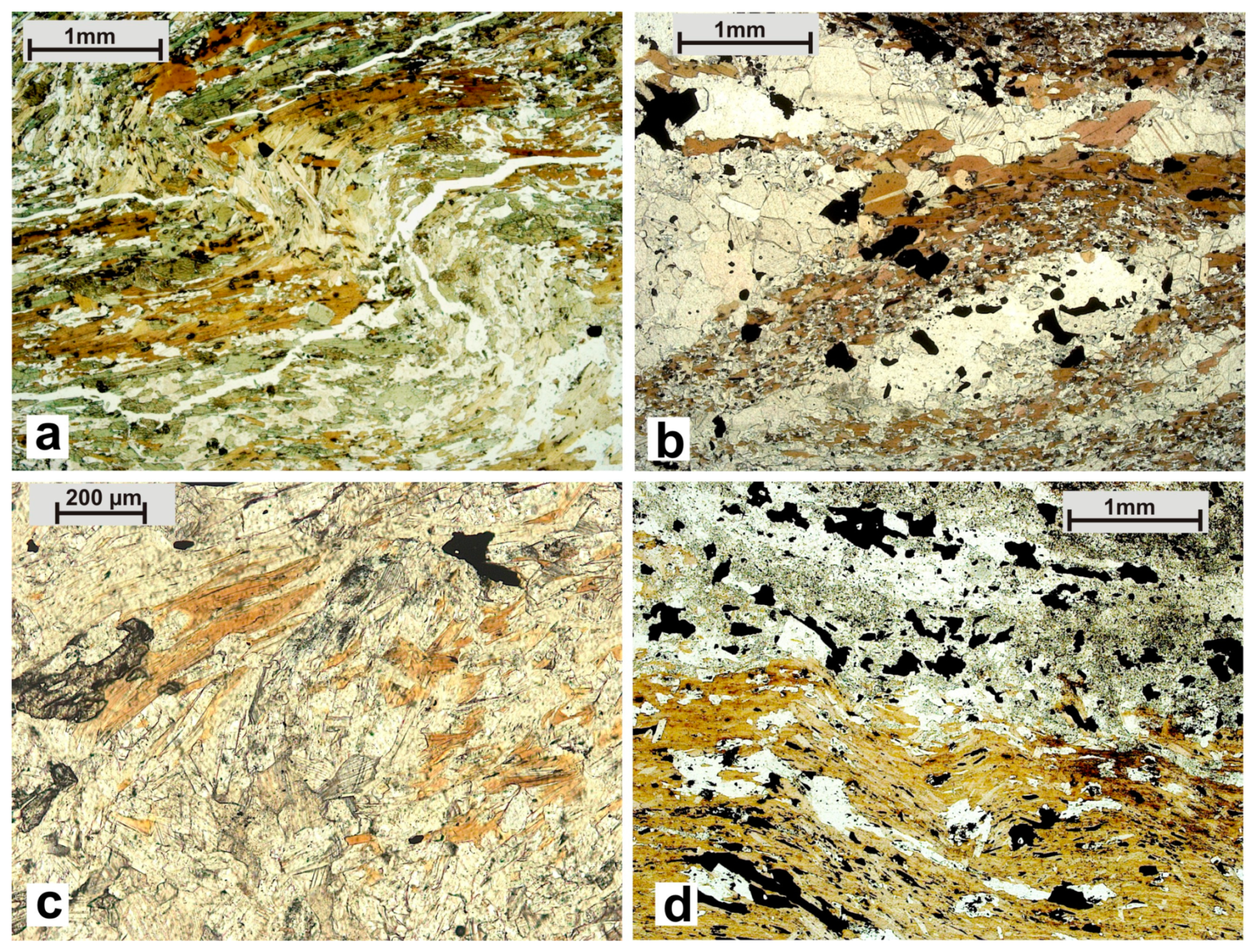
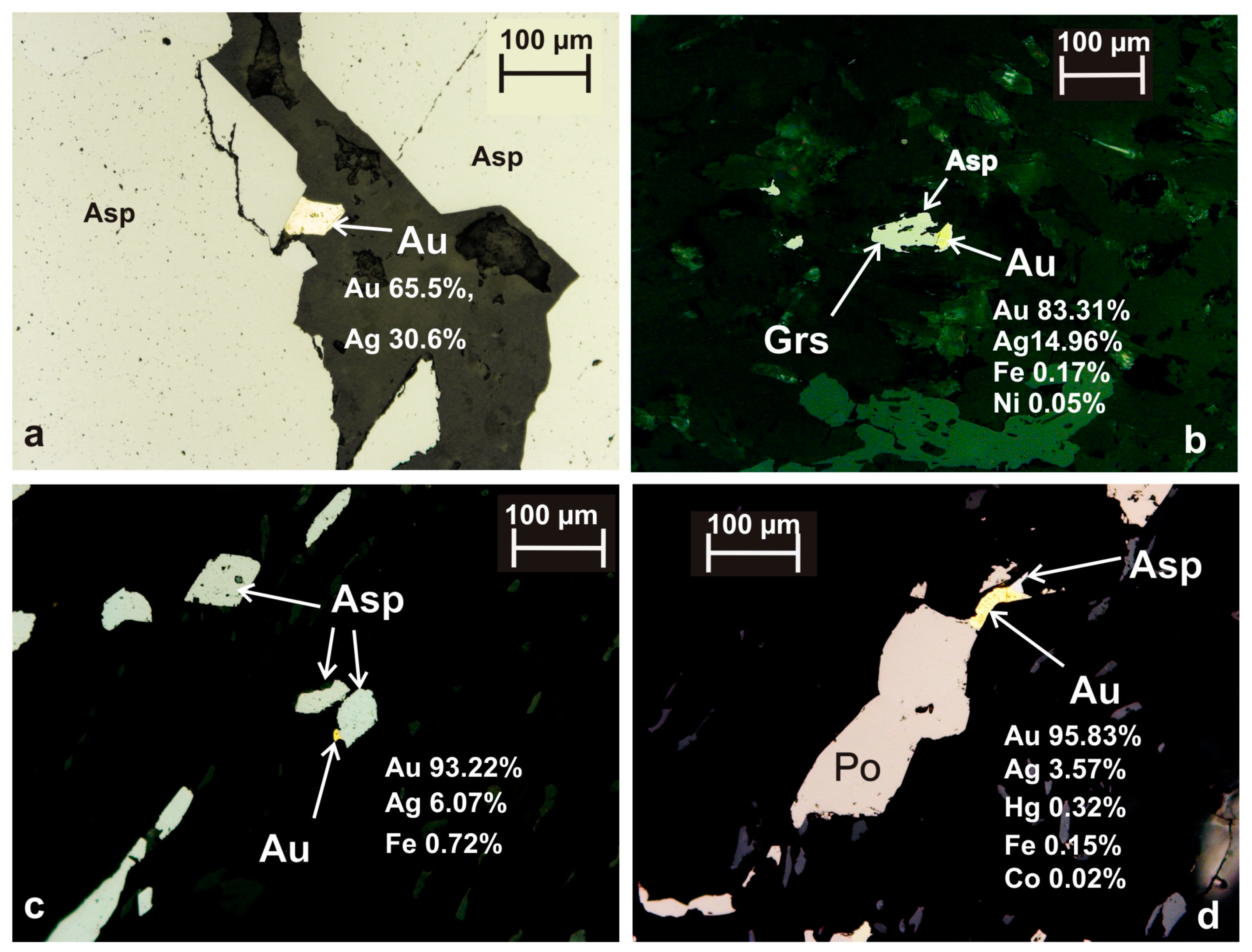


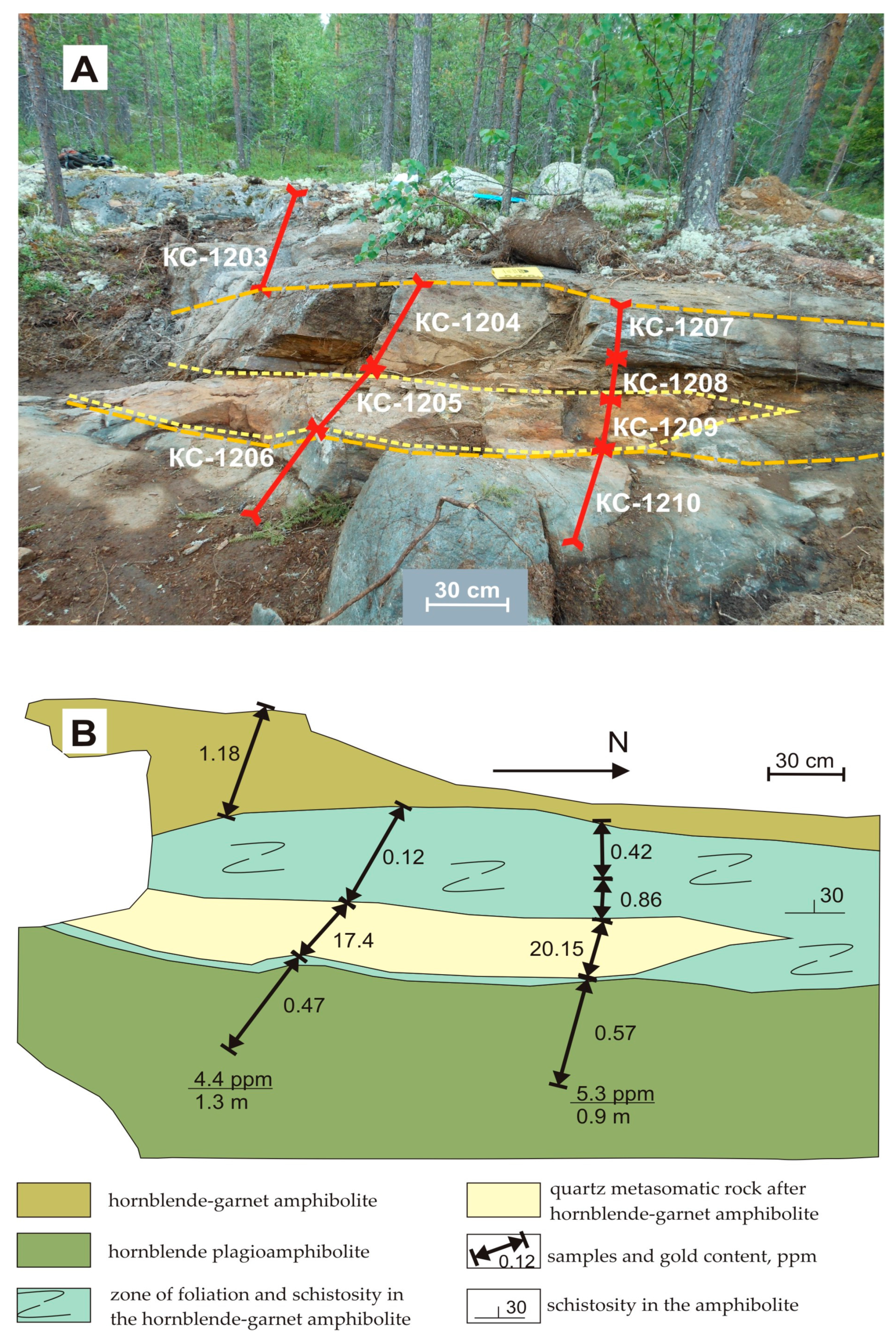
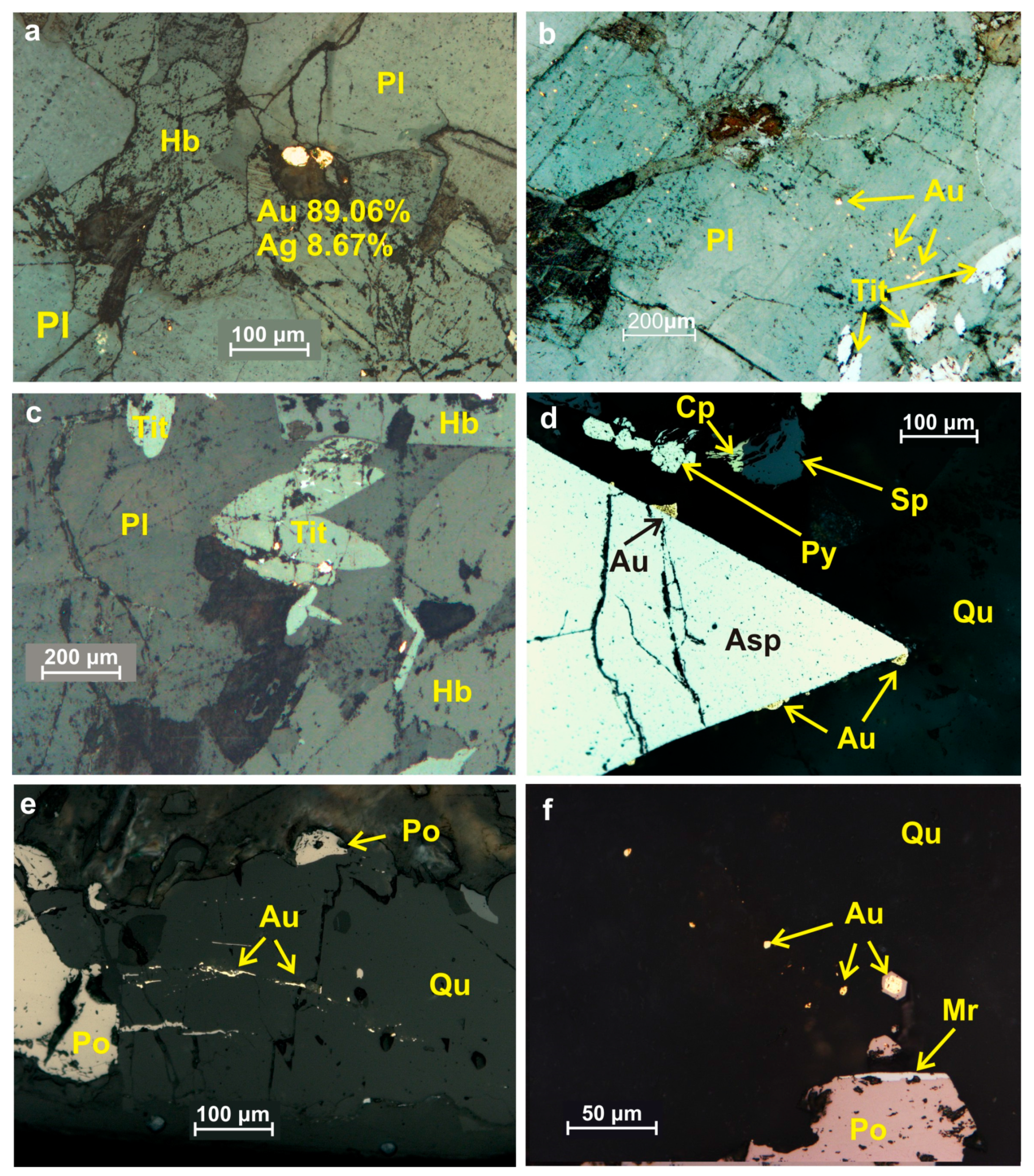

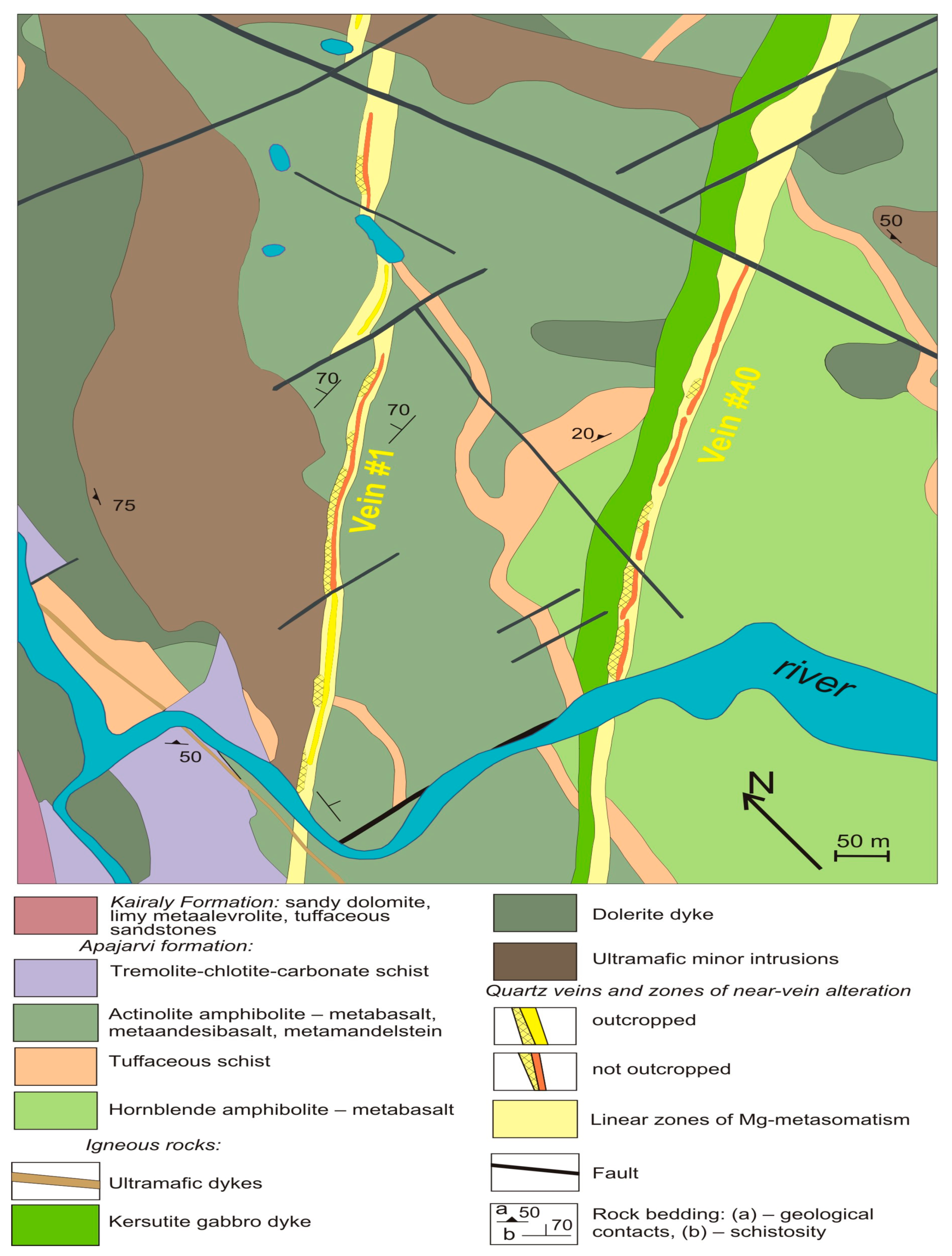
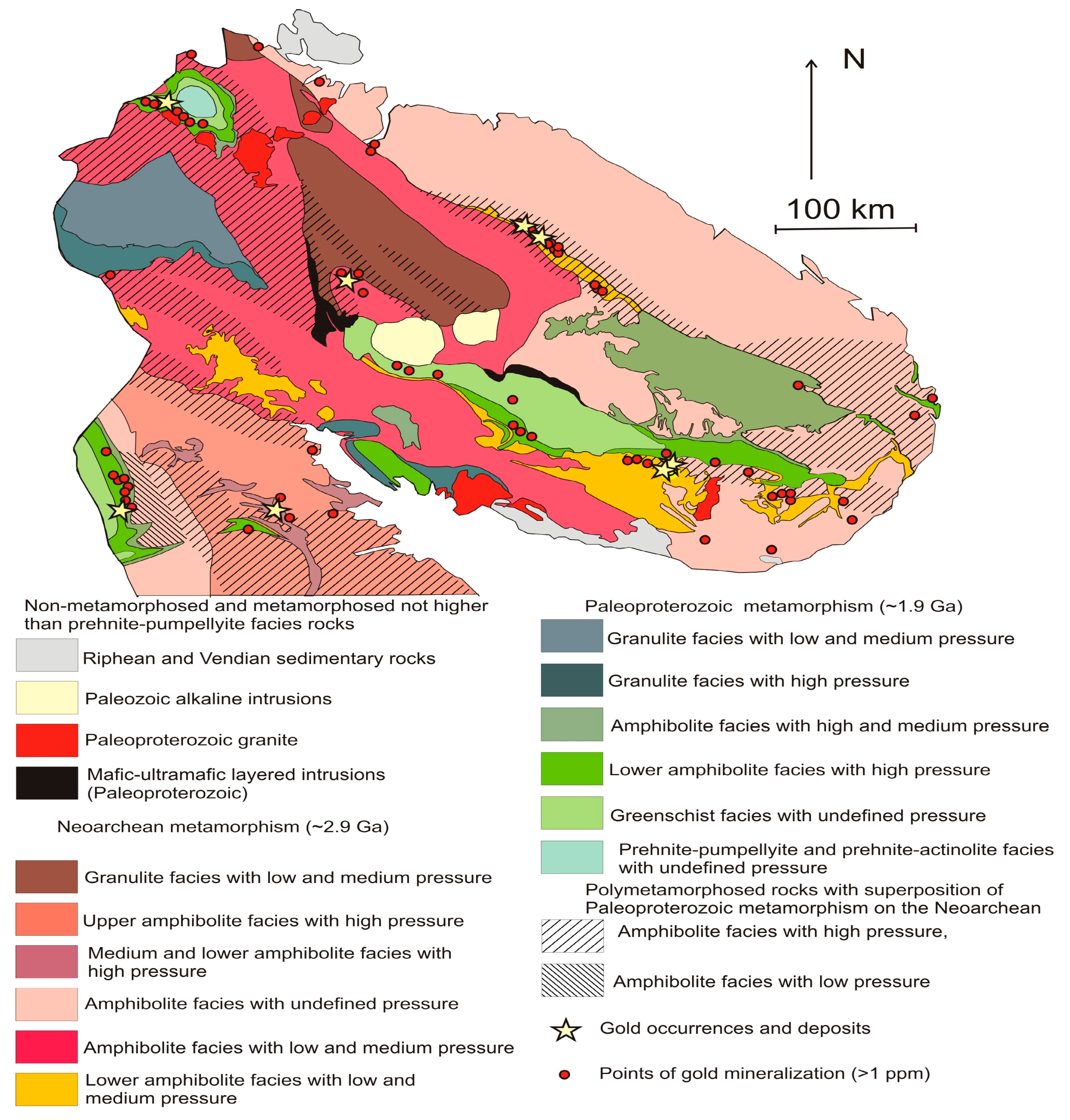
| Sample # | AK-713 | AK-708 | AK-716 | AK-715 | AK-703 | AK-704а | AK-706 | VP-10 | AK-710 | 114-79 | 114b-79 | AK-707 | AK-705 | AK-24 |
|---|---|---|---|---|---|---|---|---|---|---|---|---|---|---|
| SiO2 | 47.20 | 51.19 | 49.94 | 47.12 | 49.24 | 46.90 | 71.56 | 69.53 | 64.22 | 76.52 | 69.11 | 62.38 | 89.12 | 82.27 |
| TiO2 | 0.75 | 1.21 | 0.67 | 0.98 | 1.37 | 1.17 | 0.34 | 0.23 | 0.97 | 0.44 | 0.68 | 0.28 | 0.05 | 0.11 |
| Al2O3 | 12.20 | 11.61 | 17.00 | 15.39 | 12.89 | 12.31 | 14.69 | 16.20 | 11.91 | 8.22 | 10.64 | 2.71 | 1.62 | 2.11 |
| Fe2O3 | 0.84 | 1.76 | 0.00 | 3.39 | 1.68 | 2.60 | 0.00 | 0.48 | 1.62 | 1.51 | 4.90 | 7.99 | 0.00 | 5.31 |
| FeO | 10.64 | 10.81 | 4.40 | 8.30 | 11.35 | 10.38 | 2.38 | 1.36 | 5.18 | 4.14 | 1.78 | 6.39 | 3.01 | 2.47 |
| MnO | 0.23 | 0.21 | 0.11 | 0.27 | 0.22 | 0.25 | 0.03 | 0.03 | 0.02 | 0.04 | 0.03 | 0.02 | 0.05 | 0.03 |
| MgO | 11.20 | 5.37 | 1.84 | 5.18 | 6.49 | 5.82 | 1.18 | 1.18 | 0.19 | 1.41 | 1.22 | 0.43 | 1.17 | 0.86 |
| CaO | 12.33 | 14.31 | 19.50 | 12.93 | 10.71 | 12.32 | 2.50 | 1.74 | 0.39 | 2.35 | 2.83 | 0.65 | 2.02 | 1.14 |
| Na2O | 1.68 | 1.14 | 1.31 | 1.44 | 1.13 | 0.98 | 4.89 | 6.28 | 2.28 | 2.14 | 3.24 | 0.49 | 0.11 | 0.44 |
| K2O | 0.10 | 0.21 | 0.07 | 1.04 | 1.17 | 1.33 | 1.01 | 1.56 | 1.94 | 0.60 | 0.47 | 0.26 | 0.07 | 0.19 |
| H2O− | 0.08 | 0.04 | 0.16 | 0.03 | 0.14 | 0.39 | 0.11 | 0.00 | 0.44 | 0.29 | 0.24 | 0.67 | 0.00 | 0.22 |
| H2O+ | 2.42 | 1.06 | 1.39 | 1.14 | 1.57 | 1.69 | 0.73 | 0.83 | 2.60 | 1.15 | 0.67 | 3.86 | 0.28 | 0.28 |
| S | 0.07 | 0.60 | 0.05 | 1.37 | 1.08 | 2.46 | 0.07 | 0.01 | 1.15 | 1.95 | 2.26 | 3.57 | 0.04 | 2.20 |
| P2O5 | 0.05 | 0.10 | 0.05 | 0.06 | 0.08 | 0.11 | 0.07 | 0.06 | 0.42 | 0.01 | 0.00 | 0.46 | 0.03 | 0.13 |
| CO2 | <0.10 | <0.10 | 3.32 | 0.11 | <0.10 | <0.10 | <0.10 | 0.00 | <0.10 | 0.06 | 0.00 | <0.10 | <0.10 | 0.02 |
| F | 0.019 | 0.016 | 0.014 | 0.01 | 0.098 | 0.057 | 0.017 | 0.000 | 0.014 | 0.019 | 0.000 | 0.010 | 0.011 | 0.018 |
| Cl | 0.009 | 0.009 | 0.011 | 0.01 | 0.009 | 0.009 | 0.011 | n.a. | 0.013 | n.a. | n.a. | 0.010 | 0.007 | n.a. |
| Total | 99.85 | 99.66 | 99.85 | 98.81 * | 99.34 | 98.84 * | 99.62 | 99.51 | 93.38 * | 100.86 | 98.08 * | 90.19 * | 97.60 * | 97.80 * |
| Ag (ppm) | 0.26 | 1.46 | 0.46 | 1.68 | 2.3 | 18.05 | 0.8 | n.a. | 20.72 | n.a. | n.a. | 96.56 | 0.086 | n.a. |
| Au (ppm) | 0.016 | 0.009 | <0.004 | 1.04 | 0.49 | 1.27 | <0.004 | n.a. | 3.29 | n.a. | n.a. | 3.16 | <0.004 | n.a. |
| Pd (ppm) | <0.004 | <0.004 | <0.004 | n.a. | <0.004 | <0.004 | <0.004 | n.a. | <0.004 | n.a. | n.a. | 0.019 | <0.004 | n.a. |
| Cu | 0.01 | 0.012 | <0.005 | 0.015 | 0.016 | 0.026 | <0.005 | n.a. | 0.018 | n.a. | n.a. | 0.029 | <0.01 | n.a. |
| Ni | 0.028 | 0.009 | 0.009 | 0.019 | 0.008 | 0.01 | 0.005 | n.a. | 0.006 | n.a. | n.a. | 0.013 | 0.014 | n.a. |
| Co | <0.005 | <0.005 | <0.005 | <0.005 | <0.005 | <0.005 | <0.005 | n.a. | <0.005 | n.a. | n.a. | <0.005 | <0.01 | n.a. |
| Deposit | Oleninskoe | Nyal’m | |
|---|---|---|---|
| Tectonic structure | Intersection of NW shear zone and a sub-meridional fault | Tectonized contacts of porphyry intrusion | |
| Host rocks | Amphibolite, quartz porphyry dykes (~2.83 Ga) | Gabbrodiorite–diorite–granodiorite porphyry (~2.83 Ga) | |
| Regional metamorphism | (1) Neoarchean: 2.6–2.9 Ga, lower amphibolite T~ 600 °C, P = 3–4 kbar; (2) Paleoproterozoic: 1.8–1.9 Ga, lower amphibolite T~ 530 °C, P = 5.0–5.5 kbar. | ||
| Alteration, assemblages of new formed minerals | -pre-ore | K–Ca: Biotite, diopside-epidote-carbonate | K–Ca–(Si) Beresite (quartz–carbonate–muscovite), biotite–epidote |
| -gold-related | Si–B–(K) Quartz-tourmaline-muscovite, quartz-tourmaline, quartz | CO2–Si Stockwork of quartz–carbonate veinlets | |
| -post-ore | Near-pegmatite: biotite and holmquistite | Not defined | |
| Mineralized bodies | Mineralized lenses up to 3.5 × 50 m. The best sections: 83.8 ppm for 2.2 m in drillhole #BF-28 and 88.6 ppm for 1.5 m in BF-45 [18]; average grade 7.6 ppm Au | Mineralized stockwork up to 15-m thick with weighted average 1.2 ppm Au. The best intersections are 0.93 ppm Au for 32.8 m and 1.77 ppm for 18.4 m in two intervals in drillhole #BF-107 [18] | |
| Texture of mineralization, sulfide content (%) | Disseminated, veinlet-disseminated, 1–15 | Disseminated, 1–3 | |
| Main ore minerals | Arsenopyrite, pyrrhotite, ilmenite | Pyrrhotite | |
| Minor ore minerals | Chalcopyrite, sphalerite, galena, freibergite, sheelite, pyrite, Sb-sulfosalts, löllingite, dyscrasite, electrum, uytenbogaardtite, aurostibite, petzite, chlorargyrite. | Chalcopyrite, pyrite, cobaltite, ilmenite, arsenopyrite | |
| Geochemical association | Au–As–Ag (Sb–Cu–Pb–Zn–B–W). Au/Ag <0.2 | Au–As. Au/Ag >1. | |
| Age of mineralized rocks | Neoarchean—later than 2.83 Ga, but before 2.45 Ga | Neoarchean(?)–later than 2.83 Ga | |
| Gold characteristics, fineness | 4 types of Au–Ag alloys: 1) electrum (25–32 mas.% Au) with arsenopyrite; 2) electrum (33–47% Au) with galena and Sb-sulfosalts; 3) gold (78–95% Au) in quartz; 4) silver (<7% Au) in the weathered rocks. | Grains up to 1.0 mm in carbonate–quartz veinlets. The gold fineness is 890–940. | |
| Sample # | Type | Fe | Ni | Cu | Pb | Ag | Au | Sb | As | S | Total |
|---|---|---|---|---|---|---|---|---|---|---|---|
| 090 | 1 | 1.20 | n.a. | 0.03 | <0.01 | 72.35 | 25.52 | 0.05 | 1.61 | 0.14 | 100.91 |
| 9014-2 | 1 | 0.22 | 0.05 | 1.21 | n.a. | 64.77 | 31.34 | 1.27 | 0.53 | 0.27 | 99.66 |
| AK-707-1 | 1 | 0.12 | n.a. | n.a. | 0.88 | 77.49 | 20.87 | n.a. | n.a. | 0.59 | 99.94 |
| 700 | 2 | 0.01 | n.a. | <0.01 | <0.01 | 61.79 | 33.63 | 1.78 | <0.01 | <0.01 | 97.20 |
| 700 | 2 | 0.01 | n.a. | 0.01 | <0.01 | 55.13 | 37.29 | 2.41 | <0.01 | <0.01 | 94.86 |
| 711-8-23(C) | 2 | <0.01 | n.a. | <0.01 | n.a. | 32.14 | 62.84 | 0.29 | <0.01 | n.a. | 95.28 |
| 711-8-23(R) | 2 | <0.01 | n.a. | <0.01 | n.a. | 51.68 | 42.46 | 0.34 | <0.01 | n.a. | 94.48 |
| 711-2-1(C) | 2 | <0.01 | n.a. | <0.01 | n.a. | 52.22 | 41.14 | 1.81 | <0.01 | n.a. | 95.17 |
| 711-2-1(R) | 2 | <0.01 | n.a. | <0.01 | n.a. | 37.07 | 58.10 | 0.65 | <0.01 | n.a. | 95.81 |
| AK-711A-1 | 2 | 0.14 | n.a. | n.a. | n.a. | 39.61 | 59.17 | n.a. | n.a. | 1.04 | 99.96 |
| 700 | 2 | 0.03 | n.a. | 0.02 | <0.01 | 39.35 | 54.99 | 0.71 | <0.01 | <0.01 | 95.09 |
| 284 | 2 | 0.01 | <0.01 | <0.01 | n.a. | 34.58 | 61.16 | 0.49 | 0.08 | <0.01 | 96.32 |
| 284 | 2 | 0.02 | <0.01 | <0.01 | n.a. | 24.16 | 73.20 | 0.16 | 0.08 | <0.01 | 97.62 |
| K-13C-29/1 | 3 | n.a. | n.a. | n.a. | n.a. | 21.80 | 77.87 | n.a. | n.a. | n.a. | 99.67 |
| K-505.7 | 3 | n.a. | n.a. | 0.05 | n.a. | 12.77 | 86.65 | n.a. | n.a. | n.a. | 99.47 |
| K-027-12/1 | 3 | n.a. | n.a. | n.a. | n.a. | 12.54 | 87.18 | n.a. | n.a. | n.a. | 99.72 |
| BF-2029 | 3 | 0.05 | n.a. | 0.11 | n.a. | 12.07 | 87.83 | n.a. | n.a. | 0.14 | 100.20 |
| K-027-12 | 3 | n.a. | n.a. | n.a. | n.a. | 11.85 | 87.63 | n.a. | n.a. | n.a. | 99.48 |
| 9015 | 4 | 0.41 | n.a. | n.a. | n.a. | 89.27 | 7.15 | 3.16 | n.a. | n.a. | 99.99 |
| 107-62.8 | <0.01 | n.a. | 1.35 | n.a. | 8.73 | 89.50 | n.a. | n.a. | n.a. | 99.57 | |
| Formulae coefficients (calculated for Σ Metals = 1) | |||||||||||
| 090 | 1 | 0.025 | 0.001 | 0.000 | 0.790 | 0.153 | 0.000 | 0.025 | 0.005 | ||
| 9014-2 3a | 1 | 0.005 | 0.001 | 0.024 | 0.742 | 0.197 | 0.013 | 0.009 | 0.010 | ||
| AK-707-1 | 1 | 0.002 | 0.005 | 0.846 | 0.125 | 0.022 | |||||
| 700 | 2 | 0.000 | 0.000 | 0.000 | 0.755 | 0.225 | 0.019 | 0.000 | 0.000 | ||
| 700 | 2 | 0.000 | 0.000 | 0.000 | 0.709 | 0.263 | 0.028 | 0.000 | 0.000 | ||
| 711-8-23 | 2 | 0.000 | 0.000 | 0.687 | 0.309 | 0.004 | 0.000 | ||||
| 711-8-23’ | 2 | 0.000 | 0.000 | 0.481 | 0.515 | 0.004 | 0.000 | ||||
| 711-2-1’ | 2 | 0.000 | 0.000 | 0.684 | 0.295 | 0.021 | 0.000 | ||||
| 711-2-1 | 2 | 0.000 | 0.000 | 0.534 | 0.458 | 0.008 | 0.000 | ||||
| AK-711A-1 | 2 | 0.003 | 0.523 | 0.428 | 0.046 | ||||||
| 700 | 2 | 0.001 | 0.001 | 0.000 | 0.560 | 0.429 | 0.009 | 0.000 | 0.000 | ||
| 284 | 2 | 0.000 | 0.000 | 0.000 | 0.504 | 0.488 | 0.006 | 0.002 | 0.000 | ||
| 284 | 2 | 0.001 | 0.000 | 0.000 | 0.374 | 0.621 | 0.002 | 0.002 | 0.000 | ||
| K13C-29/1 | 3 | 0.338 | 0.662 | ||||||||
| K-505.7 | 3 | 0.001 | 0.212 | 0.787 | |||||||
| K027-12/1 | 3 | 0.208 | 0.792 | ||||||||
| BF-2029 | 3 | 0.002 | 0.003 | 0.200 | 0.796 | 0.004 | |||||
| K-027-12 | 3 | 0.198 | 0.802 | ||||||||
| 9015-1 4-1a | 4 | 0.008 | 0.922 | 0.040 | 0.029 | ||||||
| 107-62.8 | 0.000 | 0.038 | 0.145 | 0.817 | |||||||
| Mineral | Sample # | Fe | Cu | Zn | Pb | Ag | Au | Sb | As | S | Total |
|---|---|---|---|---|---|---|---|---|---|---|---|
| Dyscrasite | 700 | <0.01 | 0.02 | 0.01 | <0.01 | 76.25 | 0.08 | 23.05 | 0.02 | <0.01 | 99.43 |
| 700 | 0.03 | 0.04 | 0.03 | <0.01 | 63.64 | 12.22 | 17.93 | 0.06 | <0.01 | 98.95 | |
| 284-3 | 0.01 | 0.02 | 0.01 | 0.07 | 69.84 | 10.46 | 19.00 | <0.01 | 0.01 | 99.41 | |
| 136-1 | 0.01 | <0.01 | 0.01 | 1.26 | 76.96 | 0.44 | 20.81 | <0.01 | 0.04 | 99.54 | |
| 700 | <0.01 | <0.01 | n.a. | n.a. | 73.78 | 2.05 | 23.73 | n.a. | n.a. | 99.57 | |
| 700 | <0.01 | n.a. | n.a. | n.a. | 73.82 | 3.04 | 23.48 | n.a. | n.a. | 100.33 | |
| 700 | <0.01 | n.a. | n.a. | n.a. | 71.37 | 7.45 | 21.29 | n.a. | n.a. | 100.13 | |
| Uytenbogaardtite | AK-711-4 | 0.15 | n.a. | n.a. | n.a. | 59.86 | 26.88 | n.a. | <0.01 | 11.15 | 98.04 |
| Formulae coefficients (calculated for Sb + As + S = 1 in dyscrasite, S = 2 in uytenbogaardtite) | |||||||||||
| Dyscrasite | 700 | 0.000 | 0.001 | 0.000 | 0.000 | 3.728 | 0.002 | 0.999 | 0.001 | 0.000 | |
| 700 | 0.004 | 0.004 | 0.003 | 0.000 | 3.985 | 0.419 | 0.994 | 0.005 | 0.000 | ||
| 284-3 | 0.001 | 0.002 | 0.001 | 0.002 | 4.144 | 0.340 | 0.999 | 0.000 | 0.001 | ||
| 136-1 | 0.001 | 0.000 | 0.001 | 0.035 | 4.142 | 0.013 | 0.992 | 0.000 | 0.008 | ||
| 700 | 0.000 | 0.000 | 3.509 | 0.053 | 1.000 | ||||||
| 700 | 0.000 | 3.549 | 0.080 | 1.000 | |||||||
| 700 | 0.000 | 3.784 | 0.216 | 1.000 | |||||||
| Uytenbogaardtite | AK-711-4 | 0.016 | 3.191 | 0.785 | 0.000 | 2.000 | |||||
| Gold Deposit/Occurrence | Host Mineral | Temperature of Homogenization, °C | Fluid Composition, mole/kg | Salinity, wt.% NaCl-equivalent; Salt Composition | Pressure, Bar |
|---|---|---|---|---|---|
| Oleninskoe [19] | Diopside | 341–351 | No data | 1.1 | No data |
| Quartz with gold mineralization | 120–160 | H2O–CO2–CH4 | 13.4–13.5 Na, Ca, Mg | No data | |
| Nyal’m (this study) | Quartz from veinlets | 251–334 | H2O–CO2–CH4 CO2 4.3–5.8 CH4 0.5–0.7 | 2.5–5.6 | 1130–3290 |
| Porojarvi [22] | Quartz from metasomatic quartzite | 242–336 | H2O–CO2–CH4 CO2 4.3–7.8 CH4 0.6–0.9 | 0.4–3.8 Na, Ca, Mg, K (Au 4.6 ppm) | 1200–2580 |
| Quartz from quartz-albite- carbonate metasomatite | 342–370 | H2O–CO2–CH4 CO2 5.3–8.8 CH4 0.6–1.1 | 0.6–1.0 Na, Ca, Mg, K (Au 202 ppm) | 2130–4550 | |
| Mayskoe [23] | Quartz from propylite | 280–320 | H2O–NaCl | 25–30 | No data |
| Vein quartz | 320–350 | No data | 1.7–7.7 | No data | |
| Granulated quartz from the ore shoots | 190–270 | CO2–CH4 CH4 16–70% | 22–26 Ca | 940–500 | |
| Quartz with gold in inclusions | 140–198 | No data | 22–28 Ca | No data |
| Deposit/occurrence | Sergozero | Vorgovy | |
|---|---|---|---|
| Tectonic structure | Second-order faults, accompanying the regional overthrust of the Neoarchean Strel’na belt onto Paleoproterozoic rocks of the Imandra–Varzuga belt | Regional overthrust of the Neoarchean Strel’na belt onto Paleoproterozoic rocks of the Imandra–Varzuga belt | |
| Host rocks | Hornblendite (tholeiitic basalt), chlorite–actinolite amphibolite (komatiite, komatiitic basalt), diorite porphyry dykes | Biotite gneisses and schists with interbeds of mafic-ultramafic metavolcanics | |
| Regional metamorphism | Paleoproterozoic 1.8–1.9 Ga, greenschist—lower amphibolite | ||
| Alteration (assemblages of new formed minerals) | -pre-ore | Chlorite | Quartz-chlorite-sericite and quartz-sericite |
| -gold-related | K–CO2–Si Quartz–calcite–biotite | Si–CO2–(K) Stockwork of quartz–-carbonate and quartz veinlets | |
| -post-ore | Quartz–calcite | Not defined | |
| Mineralized bodies | Lenses up to 14-m thick and up to 150-m long. The best section is 5.3 ppm Au for 3.3 m in a drillhole by the Central Kola Expedition (CKE); average gold grade 3.1 ppm | Not contoured, the best section is 4 ppm for 1 m in a trench by the CKE | |
| Texture of mineralization, sulfide content (vol.%) | Disseminated, 1–3 | Nested, nested-disseminated, up to 0.1–5 | |
| Main ore minerals | Arsenopyrite, pyrrhotite, gersdorfite | Arsenopyrite, pyrrhotite | |
| Minor ore minerals | Ilmenite, chalcopyrite, pyrite, pentlandite, cobaltite, sphalerite, galena, sheelite | Pyrite, sphalerite, galena, chalcopyrite, pentlandite, cobaltite, marcasite, mackinawite | |
| Geochemical association, ratio Au/Ag | Au, As, Ni Au/Ag = 2–6 | Au, As Au/Ag > 1 | |
| Age of mineralized rocks | Paleoproterozoic - later than 1875 ± 2 Ga (age of the diorite porphyry dyke); Rb–Sr age of quartz–calcite–biotite gold-related mineral association 1739 ± 86 Ma | Paleoproterozoic (?) | |
| Gold characteristics, fineness in ‰ | Fine-grained (<0.1 mm) gold with fineness 760–960 in association with arsenopyrite and gersdorfite | Spongy, porous, lumpy or flattened grains 0.1–0.25 mm, the gold fineness is 890–940. | |
| Deposit/Occurrence | Kichany | Olenegorsk BIF Deposits [29,30,31] | |
|---|---|---|---|
| Greenstone belt | Tiksheozero, Kichany structure (AR) | Olenegorsk (AR) | |
| Tectonic structure | A series of thrusts in the central part of the Kichany synform | ||
| Host rocks | Hornblendite and garnet amphibolite (tholeiitic basalts), interlayered with biotite gneiss | Magnetite–sulfide quartzite | |
| Regional metamorphism | 1) Neoarchean 2.6–2.9 Ga, upper amphibolite T~ 665–700 °C, P = 7–11 kbar; 2) Paleoproterozoic ~1.8 Ga, amphibolite T~ 575–630 °C, P = 5.0–6.5 kbar | Neoarchean ~2750 Ga, amphibolite | |
| Alteration, assemblages of new formed minerals | -pre-ore | Ca Diopside–epidote–calcite–garnet, diopside–scapolte | Ca–Si Amphibole–epidote–garnet–calcite–quartz; diopside–magnetite |
| -gold-related | Si–K Quartz, quartz–biotite | Ca–Si Hydrothermal veins of quartz, calcite, diopside–calcite, hornblende–almandine, quartz–calcite–almandine composition | |
| -post-ore | Not defined | Not defined | |
| Mineralized bodies | The best section 4.4 ppm for 1.3 m in an outcrop | Average gold grade 1.36 ppm for 18 m in magnetite–sulfide quartzite, maximum 10.6 ppm | |
| Texture of mineralization, sulfide content (vol.%) | Disseminated, 1–5 | Disseminated, 1–5 | |
| Main ore minerals | Arsenopyrite, pyrrhotite, pyrite | Pyrrhotite, pyrite, chalcopyrite | |
| Minor ore minerals | Chalcopyrite, marcasite, molybdenite, sphalerite, rutile, ilmenite, gold | Galena, sphalerite, molybdenite, electrum, sulfides and tellurides of Ag, Bi, and Au | |
| Geochemical association, ratio Au/Ag | Au–As Au/Ag = 10 | No data, Au/Ag = 0.4 | |
| Age of mineralized rocks | Paleoproterozoic (?)–1739 ± 15 Ma (U–Pb, titanite with inclusions of gold) | Neoarchean 2645–2675 Ma (U–Pb, zircon from hydrothermal veins) | |
| Gold characteristics, fineness in ‰ | Fine (<0.1 mm) hexahedral and irregular gold grains in association with arsenopyrite, marcasite, inclusions in quartz and in silicate minerals (oligoclase, titanite, hornblende), rare in pyrrhotite and chalcopyrite. Gold fineness 890–910. | Gold grains from non-magnetic heavy concentrate are of tabular, flaky, hooked, or of regular form, 0.2–0.5 mm. Gold fineness from 490 to 940. | |
| Sample # | KC-1203 | KC-1204 | KC-1104A | KC-1205 | KC-1104 | KC-1206 | KC-1210 | KC-1054 |
|---|---|---|---|---|---|---|---|---|
| SiO2 | 53.51 | 52.91 | 63.28 | 64.93 | 84.14 | 47.29 | 49.06 | 40.49 |
| TiO2 | 1.44 | 1.73 | 0.81 | 1.13 | 0.27 | 0.65 | 0.65 | 1.85 |
| Al2O3 | 13.76 | 14.27 | 8.74 | 8.63 | 4.07 | 10.99 | 10.99 | 17.21 |
| Fe2O3 | 0.89 | 2.3 | 4.53 | 0.86 | 0.84 | 1.23 | 1.09 | 5.56 |
| FeO | 9.99 | 9.65 | 7.09 | 8.67 | 4.64 | 9.23 | 9.52 | 7.08 |
| MnO | 0.16 | 0.18 | 0.06 | 0.086 | 0.04 | 0.23 | 0.22 | 0.19 |
| MgO | 4.79 | 4.44 | 1.96 | 3.71 | 1.05 | 12.96 | 10.4 | 3.46 |
| CaO | 7.98 | 7.57 | 3.72 | 4.56 | 1.67 | 11.32 | 11.79 | 18.81 |
| Na2O | 2.69 | 2.96 | 1.98 | 1.58 | 0.92 | 1.4 | 1.55 | 0.96 |
| K2O | 0.79 | 0.85 | 0.47 | 0.47 | 0.25 | 0.56 | 0.57 | 0.21 |
| H2O− | 0.44 | 0.14 | 0.26 | 0.47 | 0.14 | 0.16 | 0.18 | 0.27 |
| H2O+ | 1.84 | 1.86 | 1.35 | 2.07 | 0.69 | 2.56 | 2.36 | 2.55 |
| S | 0.90 | 0.29 | 3.01 | 1.92 | 1.07 | 0.03 | 0.30 | 0.23 |
| CO2 | 0.53 | 0.43 | <0.10 | <0.10 | <0.10 | 0.23 | 0.22 | 0.73 |
| P2O5 | 0.06 | 0.07 | n.a. | 0.03 | n.a. | 0.02 | 0.02 | 0.15 |
| F | 0.013 | 0.013 | 0.009 | 0.009 | 0.005 | 0.015 | 0.013 | 0.016 |
| Cl | 0.027 | 0.033 | 0.005 | 0.015 | 0.008 | 0.012 | 0.017 | 0.017 |
| As | n.a. | n.a. | 2.86 | n.a. | 0.053 | n.a. | n.a. | n.a. |
| Total | 99.82 | 99.71 | 100.14 | 99.15 | 99.86 | 98.90 | 98.96 | 99.78 |
| Au (ppm) | 1.18 | 0.12 | 31.22 | 17.4 | 2.76 | 0.47 | 1.44 | n.a. |
| Deposit/Occurrence | Porojarvi | Mayskoe | |
|---|---|---|---|
| Greenstone belt | Pechenga, South Pechenga structure (PR) | Salla–Kuolajarvi (PR) | |
| Tectonic structure | Intersection of northwestern and northeastern fault systems | Quartz veins along dolerite and gabbropyroxenite dykes filling northeastern faults | |
| Host rocks | Biotite and muscovite-biotite schists, amphibole–chlorite and chlorite plagioschists, amphibolite. | Metabasalt, metaandesite, and their tuffs | |
| Regional metamorphism | Paleoproterozoic ~1.9 Ga, upper greenschist— lower amphibolite | Paleoproterozoic ~1.9 Ga, upper greenschist | |
| Alteration, assemblages of new formed minerals | -pre-ore | Chlorite-carbonate (propylitization) | Regional propylitization, Mg-metasomatism (Mg-amphibole–biotite–quartz, chlorite) |
| -gold-related | Si (CO2) Quartz–cummingtonite and quartz–cummingtonite–chlorite, quartz–albite–carbonate, stockwork of quartz–carbonate veinlets | K–Ba–Si Quartz–carbonate–feldspar (K-Ba) | |
| -post-ore | Not defined | Not defined | |
| Mineralized bodies | The best cross section is 3.3 ppm Au for 2.0 m in a trench by CKE | Ore shoots in quartz veins:vein #1: ore shoot length 110 m, Au 13.1 ppm;vein #40: ore shoot length 80 m, Au 10.5 ppm | |
| Texture of mineralization, sulfide content (vol.%) | Disseminated and nested-disseminated in quartzite and in carbonate-quartz veinlets, 0–2 | Streaky and disseminated in quartz veins and vein exocontacts, 1–2 | |
| Main ore minerals | Arsenopyrite, pyrrhotite | Chalcopyrite, pyrite, sphalerite | |
| Minor ore minerals | Magnetite, chalcopyrite, rutile, pyrite. | Galena, magnetite, cobaltite, marcasite, bornite, gold, sheelite, cobaltpentlandite, Bi-Pb tellurides | |
| Geochemical association, ratio Au/Ag | Au–As Au/Ag = 4–10 | Ag–Cu–Pb–Au (Zn, Co, Mo, Te, W) | |
| Age of mineralized rocks | Sm–Nd isochrone age of quartz–albite–carbonate rock with gold mineralization 1888 ± 22 Ma [38] | Propylitization 1770 ± 9 Ma (Rb–Sr isochrone) (9610 ± 30 Ma [23]), Gold from ore shoots (Re–Os isochrone) 397 ± 15 Ma [39] | |
| Gold characteristics, fineness in ‰ | Fine (<0.05 mm) gold inclusions in arsenopyrite and in quartz. Gold fineness 790–800 | Native gold in fissures in quartz, in aggregates with chalcopyrite and galena. Gold fineness 900–940 | |
| Geodynamic Conditions | Time Interval, Ga | Geological Structures (Greenstone Belts, Intrusions) | Metallogenic Events | Deposits and Occurrences |
|---|---|---|---|---|
| Formation of core of the Murmansk, Inari–Kola, Khetolambina microcontinents | >2.93 | |||
| Formation of ancient island arc systems and their accretion to microcontinents | 2.88–2.77 | Kolmozero–Voron’ya belt (paleosuture), Central Belomorian paleosuture, Tiksheozero belt system | Deposition of volcanic–sedimenary rocks, hosting epigenetic gold mineralization and gold-bearing quartz conglomerates | |
| Formation of epigenetic rift greenstone belts | 2.80–2.66 | Strel’na, Ura-Guba, Allarechka, East Pansky, Olenegorsk, etc. greensone belts | Deposition of volcanic-sedimenary rocks, hosting epigenetic gold mineralization | |
| Consolidation of microcontinents into Kenorland supercontinent (“continent-continent” collision) | 2.72–2.64 | Kolmozero–Voron’ya belt | Epigenetic gold deposits in metamorphic complexes, Mo-Cu porphyry deposits | Oleninskoe, Nyal’m-1 (Au), Pellapahk (Mo–Cu) |
| Olenegorsk belt | Epigenetic Au mineralization in BIF deposits | |||
| Rifting (mantle plume—initial stage of Kenorland break) | 2.53–2.42 | Fyodorovo-Pansky massif | Layered mafic–ultramafic intrusions (PGE, Ni–Cu deposits) | Fyodorova Tundra, Kievey, N.Kamennik, E.Chuarvy, Konttijarvi, Ahmavaara, Pennikat |
| “Dormant tectonic” period (sedimentation in intra-continental basins) | 2.3–2.11 | Salla–Kuolajarvi belt | Deposition of volcanic-sedimenary rocks, hosting epigenetic gold mineralization | |
| Rifting and re-activization of intra-continental basins, formation of intra-continental rifts of Red Sea type (mantle plume, break of Kenorland supercontinent) | 2.11–1.92 | Pechenga, Imandra–Varzuga | Layered mafic- ultramafic intrusions; intrusions of gabbro-verlite formation | Pechenga deposits (Cu, Ni + PGE, Au) (Zhdanovske, Zapolyarnoe, etc.) |
| Salla–Kuolajarvi, Pechenga, Imandra–Varzuga belts | Deposition of volcanic –sedimenary rocks, hosting epigenetic gold mineralization | |||
| Formation of Columbia supercontinent; accretionary orogenes of “igneous arc—continent” type | 1.93–1.86 | S.Pechenga zone | Epigenetic gold deposits | Occurrences in the Porojarvi area |
| Intracontinental collisions of “continent–continent” type; formation of Lapland–Kola orogen | 1.87–1.7 | Strel’na belt Tiksheozero belt | Epigenetic gold deposits | Sergozero, Vorgovy Kichany |
| Tectonic-magmatic activization in Mesoproterozoic and Paleozoic | <1.7 | Salla-Kuolajarvi belt | Quartz-vein gold deposits | Mayskoe |
© 2019 by the authors. Licensee MDPI, Basel, Switzerland. This article is an open access article distributed under the terms and conditions of the Creative Commons Attribution (CC BY) license (http://creativecommons.org/licenses/by/4.0/).
Share and Cite
Kalinin, A.A.; Kazanov, O.V.; Bezrukov, V.I.; Prokofiev, V.Y. Gold Prospects in the Western Segment of the Russian Arctic: Regional Metallogeny and Distribution of Mineralization. Minerals 2019, 9, 137. https://doi.org/10.3390/min9030137
Kalinin AA, Kazanov OV, Bezrukov VI, Prokofiev VY. Gold Prospects in the Western Segment of the Russian Arctic: Regional Metallogeny and Distribution of Mineralization. Minerals. 2019; 9(3):137. https://doi.org/10.3390/min9030137
Chicago/Turabian StyleKalinin, Arkady A., Oleg V. Kazanov, Vladimir I. Bezrukov, and Vsevolod Yu. Prokofiev. 2019. "Gold Prospects in the Western Segment of the Russian Arctic: Regional Metallogeny and Distribution of Mineralization" Minerals 9, no. 3: 137. https://doi.org/10.3390/min9030137
APA StyleKalinin, A. A., Kazanov, O. V., Bezrukov, V. I., & Prokofiev, V. Y. (2019). Gold Prospects in the Western Segment of the Russian Arctic: Regional Metallogeny and Distribution of Mineralization. Minerals, 9(3), 137. https://doi.org/10.3390/min9030137





